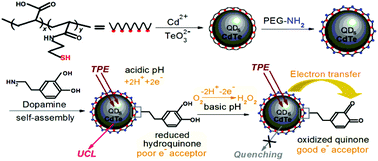Two-photon excited quantum dots with compact surface coatings of polymer ligands used as an upconversion luminescent probe for dopamine detection in biological fluids†
Abstract
Water-soluble multidentate polymer coated CdTe quantum dots (QDs) were prepared via a stepwise addition of raw materials in a one-pot aqueous solution under ambient conditions. Just by adjusting the compositions of raw materials, different sized CdTe QDs were achieved within a short time. The as-prepared QDs showed compact surface coating (1.6–1.8 nm) of polymer ligands and photoluminescence (PL) emitted at 533–567 nm, as well as high colloidal/photo-stability and quantum yields (58–67%). Moreover, these QDs exhibited significant upconversion luminescence (UCL) upon excitation using an 800 nm femtosecond laser. Experimental results confirm that the UCL was ascribed to the two-photon assisted process via a virtual energy state. Then, the two-photon excited QDs were further developed as a novel UCL probe of dopamine (DA) due to self-assembled binding of DA molecules with QDs via non-covalent bonding. As a receptor, the DA attached onto the QD surface induced an electron transfer from QDs to DA, triggering UCL quenching of QDs. This UCL probe of DA presented a low limit of detection (ca. 5.4 nM), and high selectivity and sensitivity in the presence of potential interferences. In particular, it was favorably applied to the detection of DA in biological fluids, with quantitative recoveries (96.0–102.6%).


 Please wait while we load your content...
Please wait while we load your content...